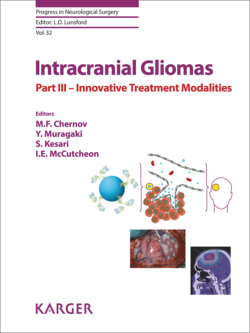Читать книгу Intracranial Gliomas Part III - Innovative Treatment Modalities - Группа авторов - Страница 46
На сайте Литреса книга снята с продажи.
Introduction
ОглавлениеIntroduction of advanced diagnostic and surgical techniques, such as functional MRI (fMRI), diffusion tensor imaging (DTI) and 3-dimensional (3D) tractography, intraoperative MRI (iMRI), fluorescence-guided resection with 5-aminolevulinic acid (5-ALA), and awake craniotomy with direct cortical and subcortical brain mapping, led to a dramatic increase in the possibilities for aggressive microsurgical removal of brain tumors [1–6]. Moreover, during the last two decades growing clinical evidence has consistently demonstrated that greater extent of resection (EOR) results in improved survival of patients with both low-grade (LGG) and high-grade (HGG) intracranial gliomas [7–10]. Additionally, in cases of LGG aggressive removal of the neoplasm may significantly reduce the risk of malignant transformation [11–13]. Finally, extensive surgical debulking of glioma may render the small-sized residual lesion more susceptible to postoperative adjuvant treatment with fractionated radiotherapy (FRT) and chemotherapy [14, 15].
Nevertheless, even with the availability of novel intraoperative neurosurgical tools, only half of intracranial gliomas in non-selected series may be considered suitable for total resection [1, 6]. The most important factor preventing aggressive surgery is tumor location within functionally important brain structures, for example, eloquent cortex, basal ganglia, or brainstem [16–18]. In such cases complete tumor removal is associated with high risk of permanent postoperative neurological deficit and deterioration of the patient’s quality of life (QOL), which frequently leads to the clinical decision to perform partial resection or just biopsy for establishment of the histopathological diagnosis [19]. Such limited surgery has been considered as the most suitable option in 35% of LGG and 14–26% of HGG [20–22], but usually results in poor outcome, since postoperative irradiation and chemotherapy have low efficacy in these cases. For example, mean survival of patients with “unresectable” glioblastoma multiforme (GBM) varies from 9 weeks to 6.6 months only [7, 23, 24], which emphasizes the necessity to develop more effective therapeutic strategies. The use of minimally invasive stereotactic treatment techniques based on modern neuroimaging may be beneficial in such cases.
Cryodestruction is a well-known modality applied in modern oncological practice for management of nasal polyps, neoplasms of the skin, prostate cancer, pituitary adenomas, meningiomas, and gliomas [25, 26]. Experimental studies demonstrated that cryoablation induces the death of neoplastic cells and improves cellular immunity and antitumor immune response [27]. In 1971, Kandel and Biezin [28] introduced the technique of stereotactic cryodestruction of brain tumors without removal of the lesion; they used pneumoencephalography and angiography for navigation during the procedure. In our opinion, the availability of modern neuroimaging modalities and neuronavigation technologies makes it possible for surgeons to revisit the possible role of this method in management of intracranial gliomas not suitable for aggressive microsurgical resection. This chapter highlights the personal clinical experience of the authors with such treatment modality.
